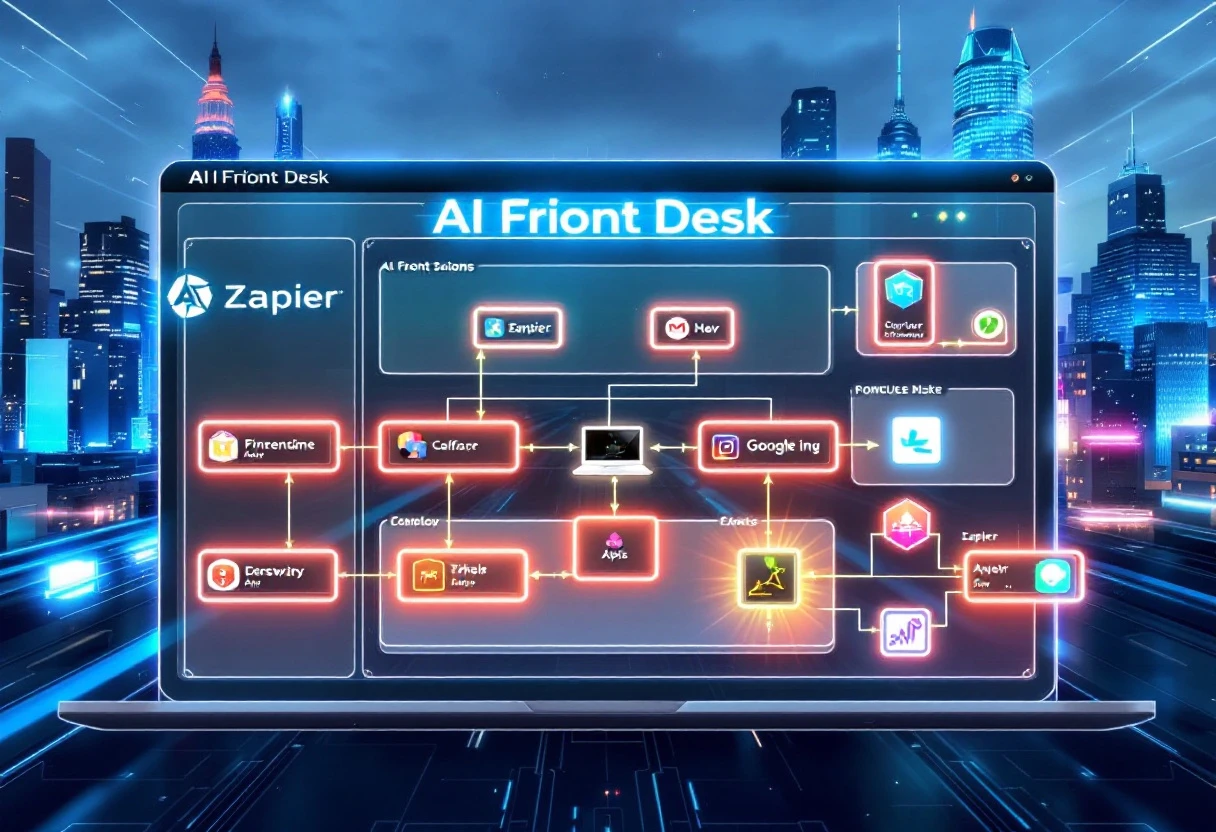
As customer expectations for immediate support continue to rise, businesses are increasingly turning to automated IT solutions to enhance their service delivery. By implementing AI-driven technologies, companies can ensure 24/7 availability, streamline processes, and improve customer satisfaction. Discover how these automated solutions can transform your customer service experience and drive business success.
Customers now expect businesses to be available around the clock. According to a recent study, 70% of consumers want immediate responses to their inquiries. These high expectations are forcing companies to rethink how they deliver support. When businesses lack automation, they struggle to meet these demands.
Missed calls and long wait times can lead to frustrated customers, potentially costing companies both reputation and revenue. Small to medium-sized enterprises often experience this challenge most acutely, lacking the resources to maintain a dedicated support team. Understanding customer feedback is vital in adapting strategies to their needs, especially in non-business hours.
Many businesses attempting to offer 24/7 support without a robust system face significant hurdles. Long hold times can frustrate customers who expect instant solutions. A staggering 60% of customers will abandon a call if met with hold times exceeding one minute. This isn't just a matter of inconvenience; it's a direct path to lost sales and damaged trust.
Additionally, inconsistent service during non-business hours creates confusion. When customers encounter varying levels of assistance, the experience suffers. Companies that can integrate automated service solutions are better positioned to provide a seamless customer journey.
For example, many firms have implemented an AI-powered approach to handle inquiries. This allows them to manage a high volume of requests efficiently and accurately. In a tech-savvy environment, automated IT support can streamline operations, ensuring that customer needs are consistently met.
Automated IT support radically changes how businesses operate. Adopting tools like an Automated AI Receptionist enables businesses to respond to inquiries effectively, regardless of the hour. With automation, routine questions can be directed to an AI system, facilitating quicker resolutions.
Steps to implement automated IT support include:
This transformation can be visually represented. Consider a size comparison of traditional support channels versus automated platforms in terms of response speed, user satisfaction, and operational cost. Harnessing data shows that companies utilizing automated systems can reduce response times by over 50% while improving customer satisfaction ratings.
“Automated solutions open the door to better customer engagement, enabling teams to focus on more complex issues.”
In summary, businesses that embrace automated IT support are well-equipped to enhance their customer experience. Factors like response speed and availability become competitive advantages that are difficult for those who stick to traditional support models to match. With tools and strategies in place, companies can foster lasting relationships with their customers, driving loyalty and growth.
Explore more about best practices in customer support and discover how automation can reshape your customer experience into a more engaging and efficient journey.
Integrating AI Front Desk with Zapier opens up a world of automation that simplifies complex business workflows. By connecting your apps, you can create seamless processes that save time and reduce manual errors. For instance, a common scenario involves automatically updating CRM records after a customer service call. Instead of entering details manually, the integration updates records based on information gathered during the interaction. This leads to a more efficient workflow and helps staff focus on delivering excellent customer service.
Data shows that businesses can reduce operational costs by as much as 30% through automation, which points to the power of automated systems. This efficiency not only enhances internal processes but also significantly improves the customer experience.
The beauty of integrating AI Front Desk with Zapier lies in its versatility. Here are a few scenarios where automation can make a real difference:
By implementing these automated processes, businesses can not only save time but also drastically improve their response times. Companies that embrace these integrations often experience shorter service resolution times and higher customer retention rates.
Setting up automation with AI Front Desk using Zapier is straightforward. Here’s a quick step-by-step guide:
Incorporating automated IT support through these integrations can significantly optimize operations across various departments. For instance, customer service representatives can find their workflow considerably enhanced with less time spent on repetitive tasks and more time dedicated to solving customer issues.
"In the age of digital transformation, those who automate their workflows will lead the pack in customer satisfaction." - Tech Industry Expert
As businesses adopt new tools, they are discovering that integrating AI for automated support not only saves time but significantly lifts the quality of customer interactions.

Missed messages can lead to lost opportunities and frustrated customers. With AI Front Desk's intelligent voicemail feature, businesses can now automatically transcribe voicemail messages. This not only saves time but also ensures clarity in communication.
Consider a retail company that recently incorporated this feature. On average, they were missing around 30% of customer inquiries due to unreturned calls. After implementing intelligent voicemail transcription, they reported a significant drop in missed opportunities. They not only recovered lost leads but also improved their customer engagement strategies. This is a prime example of how automation can streamline processes and enhance customer experiences.
Data Point: According to recent studies, businesses that utilize automated IT support features like intelligent voicemail see up to a 40% increase in response efficiency. This clearly underscores the potential benefits of adopting such technologies.
Once voicemail messages are transcribed, the next challenge lies in effective organization and retrieval. AI Front Desk simplifies this by categorizing messages based on urgency and context. Users can access these transcriptions anytime, anywhere.
For instance, a healthcare provider using AI Front Desk had concerns over managing patient communications. With automated organization, they found they could respond more quickly and accurately to patient needs. This helped enhance their patient communication methods and boost overall satisfaction.
Notification systems further improve the experience. Immediate alerts ensure that no important communication falls through the cracks. Businesses can establish responsiveness metrics using this feature, contributing significantly to their response time improvement strategies.
In today’s competitive landscape, effective customer engagement strategies are essential. AI Front Desk's voicemail capabilities facilitate this by fostering timely interactions. When a customer leaves a message, the transcribed version is sent to relevant team members in real-time.
One hospitality business saw engagement levels soar after integrating this automated system. Customers appreciated timely responses, leading to a rise in bookings. Their approach to managing customer inquiries efficiently has set a benchmark in their industry.
"This feature has changed how we engage with our customers. We now respond faster than ever, making a significant difference." - Industry Expert
The results speak for themselves. As businesses leverage technologies like these, they enhance customer experiences, resulting in improved loyalty and better service outcomes. For those interested in transforming their communication, exploring options like AI Front Desk’s Automated AI Receptionist could be a crucial step forward.
During peak business hours, managing high call volumes can feel like a daunting task for many businesses. Imagine a retail store preparing for a major holiday sale or an e-commerce website launching a new product. The phones start ringing off the hook, and responding to each customer promptly becomes a significant challenge.
Enter the unlimited parallel call feature of the Automated AI Receptionist. This capability allows businesses to handle multiple inbound calls simultaneously without compromising service quality. In industries where customer engagement directly correlates with sales, this feature is invaluable.
For example, during Black Friday sales, a retail chain may experience call volumes that surge by as much as 80%. With traditional systems, calls may go unanswered, leading to frustrated customers. However, an AI receptionist can manage numerous queries at once, ensuring that every customer gets the information they need without long wait times. Simply put, this technology makes it possible to maintain customer satisfaction even during peak demand periods.
Consider an e-commerce business introducing a limited-time offer. Up to 60% of customers may need assistance during such promotions, from checking product availability to tracking orders. Using an AI receptionist, the business can simultaneously respond to inquiries while automating bookings and orders, thus streamlining operations.
Let's say a clothing retailer launches a new summer collection and promotes it on social media. The expected influx of inquiries might overwhelm a human support team, leading to slow response times. However, an AI solution adapts quickly—taking multiple calls, managing chat inquiries, and even responding to emails efficiently. This adaptability is mirrored in statistics indicating that AI can reduce response times by up to 75%.
As Danilo Vargas, a customer experience expert, noted,
“Using AI in customer service equips businesses to meet customers' evolving expectations, especially during high-demand periods.”
When customers experience seamless communication, they’re more likely to complete their transactions. With the unlimited parallel call feature, the AI receptionist empowers businesses to prioritize customer needs effortlessly. Whether it’s summer sales, holiday clearances, or product launches, this technology can effectively handle inquiries without sacrificing quality.
Key benefits of automated IT support include:
To ensure successful implementation, businesses should adopt effective AI deployment strategies. This involves training the AI system thoroughly for specific customer interactions and scenarios, which enhances its performance.

Moreover, incorporating customer feedback can help refine the AI's understanding of customer needs, driving even better service in the future. As the role of customer service continues to evolve, leveraging AI-powered solutions like the Automated AI Receptionist presents an opportunity to stay ahead in the competitive landscape.
In summary, the implementation of an unlimited parallel call feature is a game-changer for businesses grappling with high call volumes. As retail and e-commerce continue to grow, prioritizing customer service via automation is not just preferable; it’s essential. For businesses looking to learn more about integrating AI into their service strategies, consider exploring current AI customer service trends and success stories from peers in your industry.
Imagine a customer calling in for assistance—perhaps they’re having trouble with an order or need account information. With automated texting workflows during these calls, the experience changes significantly. Instead of waiting on hold or navigating complex menus, customers receive instant text updates detailing their inquiry's status and next steps. This immediate engagement keeps them informed and reduces anxiety.
For example, if a customer requests a service update, an automated response could include key details like expected wait times and a summary of their query. This kind of smart communication streamlines not just the process but also improves overall satisfaction. According to recent research, businesses that implement automated IT support experience a 25% increase in customer satisfaction ratings. This is because real-time communication feels responsive and personal, which fosters trust.
Let's consider a few scenarios that illustrate how automated texting can enhance customer interactions:
Automating these workflows leads to quicker resolutions. A study has shown that businesses using such processes report a 40% decrease in average handling time. This means agents can handle more requests efficiently, focusing on complex issues rather than everyday queries. To learn more about effective implementations, you might want to explore best practices in customer service automation.
The effectiveness of automated texting lies in its ability to provide intelligent responses. When integrated with AI, these workflows can analyze incoming requests and tailor responses based on a customer’s history and preferences. Consider a situation where a frequent buyer calls regarding a product they recently purchased. An automated text can immediately provide specific information about that product, creating a seamless experience.
According to experts, such personalized interactions can boost customer engagement by up to 30%. As one expert notes,
“Today’s customers expect immediate answers and tailored experiences. Automation helps meet these expectations without losing the personal touch.”To see the benefits in action, businesses can study detailed case studies on seamless workflows by searching for case studies on customer service automation.
Moreover, using data-driven insights from previous interactions can refine future communications. This continuous improvement leads to more relevant responses, further enhancing customer satisfaction. Additionally, learning about the role of AI in customer service can provide deeper insights into how these systems work.
Implementing automated texting workflows opens up numerous opportunities for enhancing customer experiences. With improved resolution times and personalized responses, organizations can cultivate lasting relationships with their customers. For those interested in transforming their customer service approach, exploring tools like the Automated AI Receptionist at AI Front Desk could be a significant step forward.
Automated IT support can significantly lift customer engagement levels. By leveraging solutions like AI Front Desk, businesses can provide rapid responses to inquiries at any time. Customers appreciate swift resolutions, which fosters trust and loyalty. A case study of a mid-sized e-commerce firm showed that after implementing an automated IT support system, customer satisfaction ratings improved by 30% within six months. The integration of automated systems allows businesses to manage high volumes of queries without compromising the quality of service.
According to recent data, companies that utilize automated customer support solutions can handle 80% of inquiries without human intervention. This not only saves time but also reduces operational costs. When customers know they can get help quickly, their overall experience improves, contributing directly to smoother transactions.
Operational efficiency is crucial for any thriving business. Automated IT support streamlines processes by handling routine tasks, freeing up staff for more complex issues. For example, by using an automated help desk software, your team can reduce the time spent on repetitive troubleshooting and focus on solving more significant problems. This not only boosts productivity but also enhances employee satisfaction.
Consider the implications of integrating a system like AI Front Desk that provides 24/7 support. Organizations can operate continuously, addressing inquiries and issues outside normal business hours. This ensures that no request goes unanswered, and service levels remain high around the clock. By eliminating downtime, companies can also increase revenues significantly.
Happy customers are likely to return and recommend your service to others. By investing in automated IT support, businesses can create a seamless customer journey that leads to increased sales. With features such as instant response systems and real-time tracking, customers feel valued and understood. When customers have their needs met promptly, they are more inclined to make larger purchases. In fact, data shows that companies with effective automated support systems can see a sales boost of up to 15%.
As organizations seek growth, focusing on customer experience becomes paramount. Utilizing customer feedback tools can help tune the automated support systems further, ensuring they align with customer expectations. Moreover, analytics provided by solutions like AI Front Desk enable businesses to adapt their services based on real-time data, staying ahead of competitors.
"The greatest customer service is no service at all." - Anonymous
This quote emphasizes the goal of automated IT support: to refine customer interactions to the point where inquiries are rarely necessary. By achieving this level of efficiency, companies pave the way for sustainable growth and prosperity.
Automated IT support uses technology to handle customer inquiries and services without needing human intervention. This can include AI chatbots, automated emails, and virtual receptionists.
Automation can provide faster responses, reduce wait times, and ensure 24/7 availability. This helps meet customer expectations and increases satisfaction.
Automated systems are best for routine inquiries. However, they can work alongside human agents to provide complex support when necessary.
Industries like e-commerce, healthcare, and travel often see significant benefits from 24/7 automated support, as they require constant communication with customers.
AI-driven technology can offer personalized responses, handle multiple inquiries at once, and engage customers quickly, thus improving overall interaction quality.
The cost can vary based on the system and vendor. However, many businesses find that automation saves money in the long run by reducing operational costs and improving efficiency.
Companies can track key performance indicators (KPIs) such as response times, customer satisfaction scores, and the volume of inquiries handled automatically to assess success.
Businesses should identify common inquiries, choose appropriate tools, integrate them with existing systems, and monitor performance for constant improvement.
Start your free trial for My AI Front Desk today, it takes minutes to setup!








